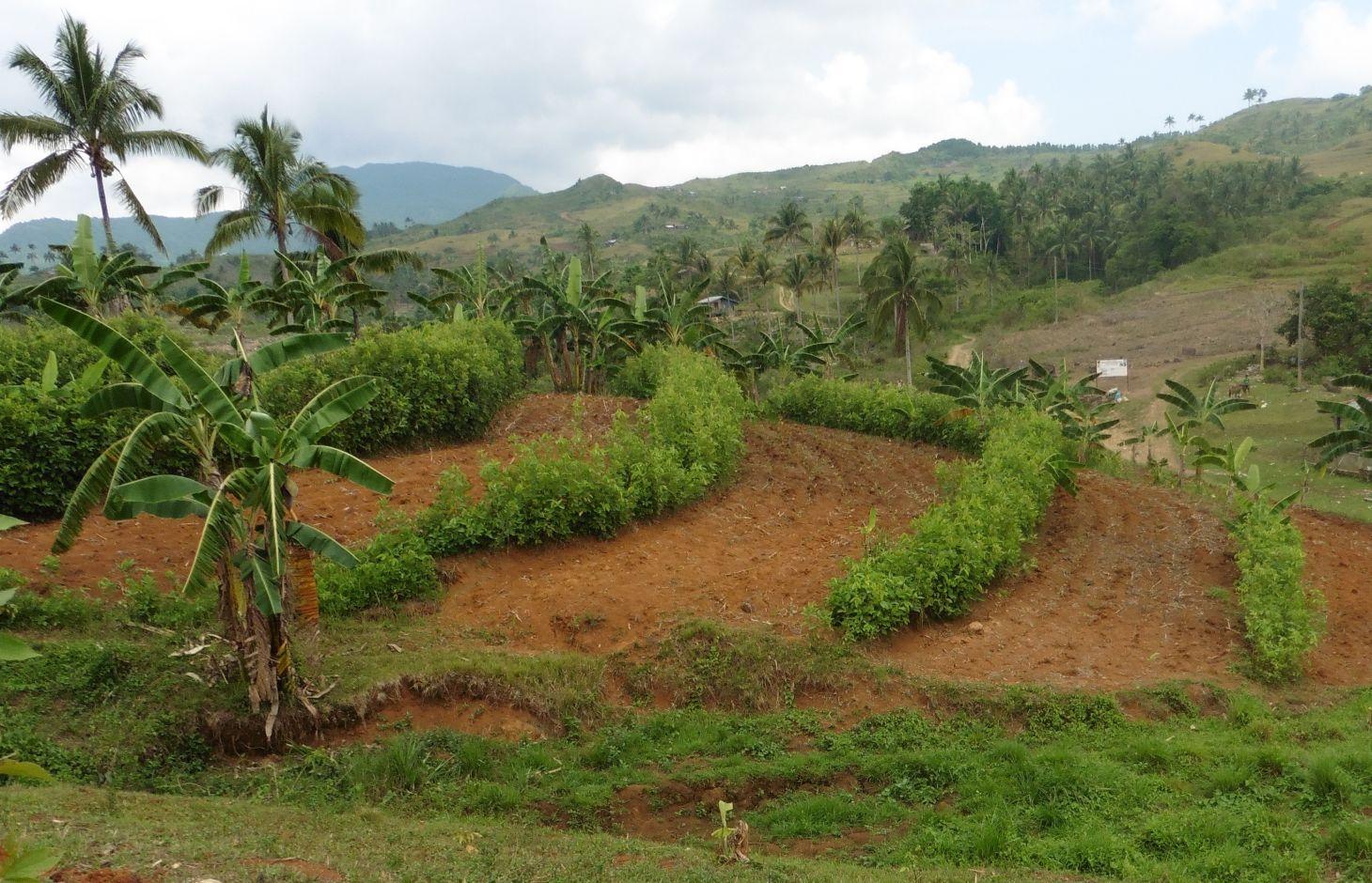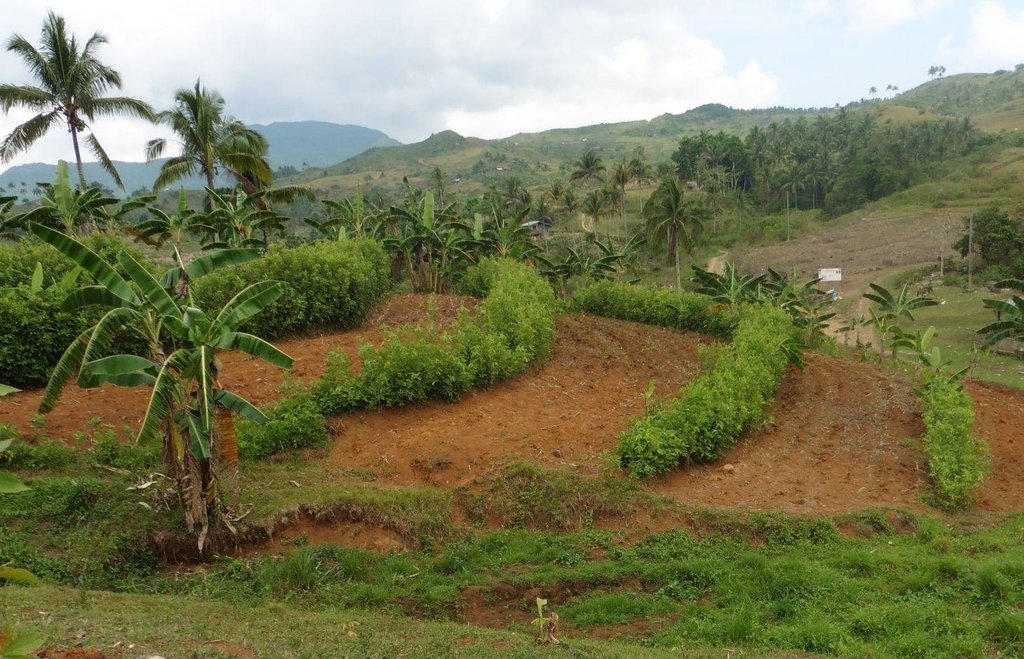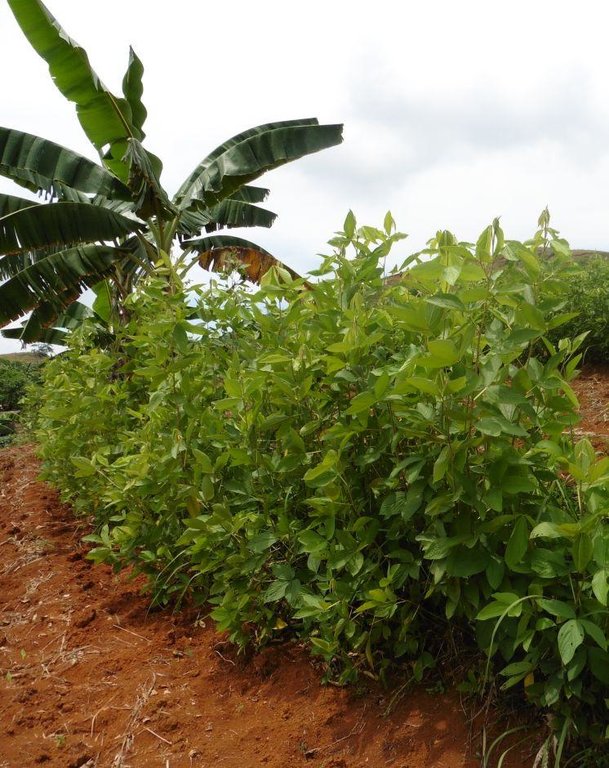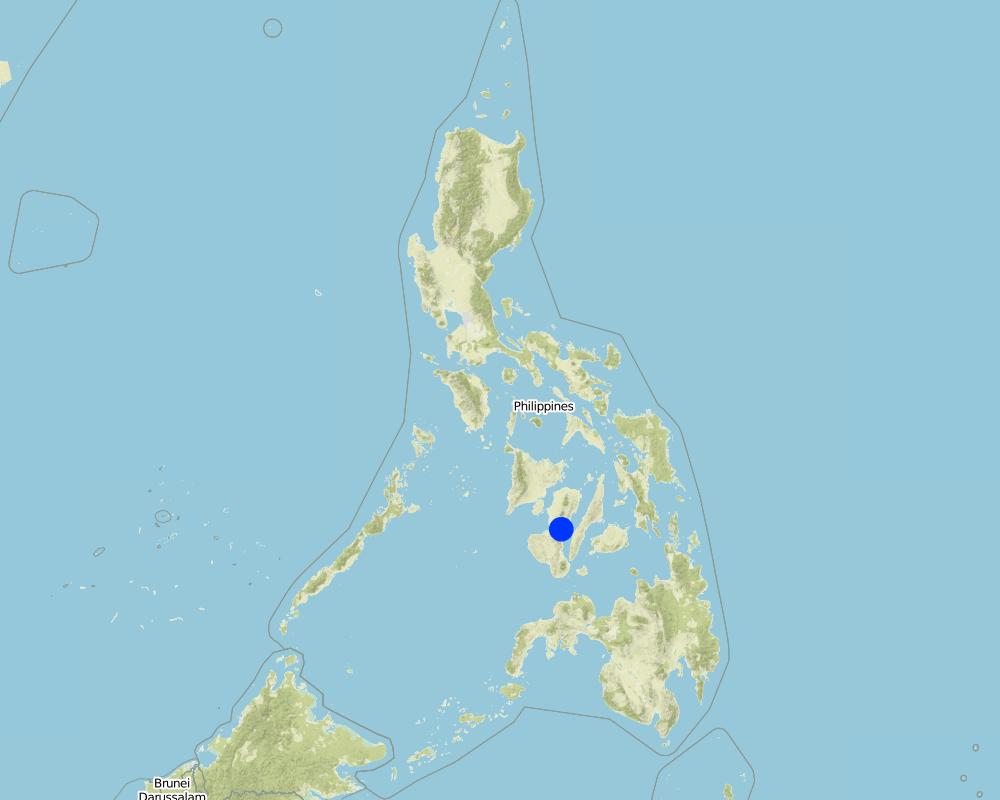Conservation Farming Village [Philippines]
- Creation:
- Update:
- Compiler: Philippine Overview of Conservation Approaches and Technologies
- Editor: –
- Reviewer: Deborah Niggli
approaches_1969 - Philippines
View sections
Expand all Collapse all1. General information
1.2 Contact details of resource persons and institutions involved in the assessment and documentation of the Approach
Key resource person(s)
SLM specialist:
SLM specialist:
Cruz Dr. Rex Victor O.
University of the Philippines Los Baños
College, Laguna, Philippines, (+6349) 536 5314
Name of project which facilitated the documentation/ evaluation of the Approach (if relevant)
Decision Support for Mainstreaming and Scaling out Sustainable Land Management (GEF-FAO / DS-SLM)Name of the institution(s) which facilitated the documentation/ evaluation of the Approach (if relevant)
Department of Agriculture-Region VIII (DA-8) - PhilippinesName of the institution(s) which facilitated the documentation/ evaluation of the Approach (if relevant)
Farming Systems and Soil Resources Institute, University of the Philippines Los (Farming Systems and Soil Resources Institute, University of the Philippines Los) - PhilippinesName of the institution(s) which facilitated the documentation/ evaluation of the Approach (if relevant)
Municipality of La Libertad, Negros Oriental, Philippines (Municipality of La Libertad) - PhilippinesName of the institution(s) which facilitated the documentation/ evaluation of the Approach (if relevant)
Silliman University, Dumaguete, Philippines (Silliman University) - Philippines1.3 Conditions regarding the use of data documented through WOCAT
When were the data compiled (in the field)?
06/08/2015
The compiler and key resource person(s) accept the conditions regarding the use of data documented through WOCAT:
Yes
1.4 Reference(s) to Questionnaire(s) on SLM Technologies
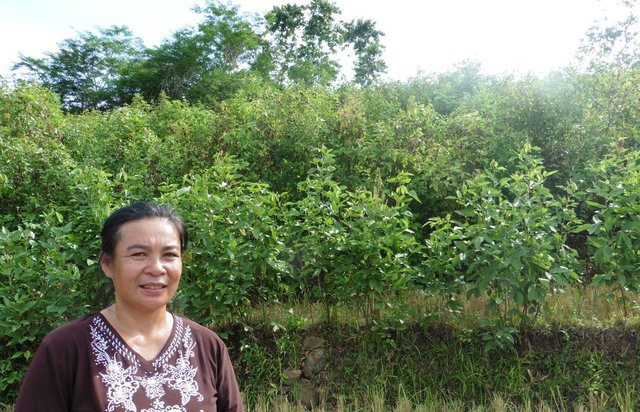
Seed Production of Multipurpose Shrubs/Legumes [Philippines]
Seed production of multipurpose shrubs and legumes, a soil conservation practice in sloping areas wherein flemingia (Flemingia macrophylla) and Indigofera (Indigofera tinctoria) are densely planted along contours.
- Compiler: Philippine Overview of Conservation Approaches and Technologies

Contour Farming using hedgerows [Philippines]
Contour farming is a technology practiced in sloping areas in which hedgerows are established along the contours and other annual/cash crops are grown in the alleys between the hedges.
- Compiler: Philippine Overview of Conservation Approaches and Technologies
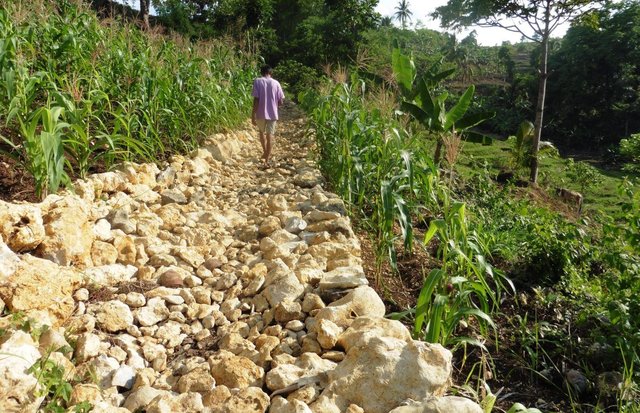
Rockwall Terracing [Philippines]
Rockwall terracing refers to the piling of stones or rocks along contour lines to reduce soil erosion in hilly areas.
- Compiler: Philippine Overview of Conservation Approaches and Technologies
2. Description of the SLM Approach
2.1 Short description of the Approach
A modality in mobilizing resources for sustainable upland development which utilizes a basket of strategies, technologies, and interventions to catalyze the widespread transformation of traditional upland farming systems into resilient and sustainable upland production systems.
2.2 Detailed description of the Approach
Detailed description of the Approach:
The objectives of Conservation Farming Village (CFV) are the following: to enhance farmers' adoption of sloping land management technologies through Science and Technology-based farming; to capacitate key groups and stakeholders in the community to better manage fragile upland resources; to conduct sustainability exercises to ensure sustainability of upland community development; to establish linkages among research-extension agencies and organizations for capacity building; and to provide support systems for the conservation farming communities.
The methods involved in the approach include capacitating upland farmers for sustainable development; strong Local Government Unit (LGU) support system; and establishing collaborative linkages and partnership as a tool for an enhanced support system.
The project of CFV in La Libertad, Negros Oriental was initiated in 2009. The first stage in the implementation of the approach is program orientation followed by community profiling. Then, Community Organizing or People's Organization strengthening. After that, technical trainings, barangay development council and municipal development council meetings were conducted to capacitate the farmers. Farm establishment was done through 'bayanihan' or group volunteerism, and lastly, farmers were encouraged to participate in the CFV.
The National Program Coordinating Office, Philippine Council for Agriculture, Aquatic and Natural Resources Research and Development (PCAARRD) and academic institutions (University of the Philippines Los Baños, Silliman University) provided technical support in the conceptualization and implementation of CFV. The LGU of La Libertad conducted the following : (1) capacity building for farmer volunteers and adopters; (2) assist in the establishment of science and technology-based conservation model farms; (3) incorporate CFV activities in the LGU Annual Investment Plan; and (4) provision of livelihood ans support mechanisms to farmers.The implementation of the CFV project became a focal point of convergence of relevant and related activities being undertaken in the upland communities of La Libertad by Non-Government Organizations (NGOs), Government Offices (GOs) and other institutions.Through this approach, the farmers have made linkage with other service providers that enhanced the farmers' access to examine other technology options, livelihood opportunities, credit and financing source, and others that may help the farmers.
2.3 Photos of the Approach
2.5 Country/ region/ locations where the Approach has been applied
Country:
Philippines
Region/ State/ Province:
La Libertad, Negros Oriental
Map
×2.6 Dates of initiation and termination of the Approach
Indicate year of initiation:
2009
2.7 Type of Approach
- project/ programme based
2.8 Main aims/ objectives of the Approach
The CFV addresses the development,application,and validation of integrated farming systems in which holistic technology transfer and emphasis on sustainable development dimensions - environmental, economic, social - are the major driving forces for economic and environmental security.
2.9 Conditions enabling or hindering implementation of the Technology/ Technologies applied under the Approach
social/ cultural/ religious norms and values
- enabling
Selection of farmer volunteers to be included in the CFV program and establishment of model farms. Government executives were invited to participate in farmers' field day in remote upland villages to show to the farmers their intention to support the program.
availability/ access to financial resources and services
- enabling
Incorporation of the CFV program in the Annual Investment Plan (AIP) of the LGU of La Libertad, Negros Oriental
institutional setting
- enabling
Farmers' organizations were organized and strengthened by mobilizing the 'Dagyaw Team' or Volunteers Group for the establishment of CFV model farms.
knowledge about SLM, access to technical support
- enabling
Provided series of technical training on the concepts and practices in CFV to the Barangay Development Councils (BDCs), Farmer Association, Municipal Development Councils (MDCs) and other stakeholders to enhance awareness on land degradation in the uplands and other environmental issues.
3. Participation and roles of stakeholders involved
3.1 Stakeholders involved in the Approach and their roles
- local land users/ local communities
Land user from the upland barangay
- SLM specialists/ agricultural advisers
LGU of La Libertad
If several stakeholders were involved, indicate lead agency:
Local land users
3.2 Involvement of local land users/ local communities in the different phases of the Approach
| Involvement of local land users/ local communities | Specify who was involved and describe activities | |
|---|---|---|
| initiation/ motivation | passive | Ten model farms were selected from CFV barangays. |
| planning | interactive | Participation in meetings, sharing inputs. |
| implementation | interactive | Model farm establishment and maintenance, Farmer volunteers serve as local extension agents to fellow farmers. |
| monitoring/ evaluation | interactive | Participation in consultation meetings, farm record keeping |
| research | passive |
3.3 Flow chart (if available)
Description:
Organizational structure in the implementation of CFV
Author:
Dr. Rex Victor O. Cruz, University of the Philippines, Los Baños
3.4 Decision-making on the selection of SLM Technology/ Technologies
Specify who decided on the selection of the Technology/ Technologies to be implemented:
- mainly land users, supported by SLM specialists
Explain:
Technical staff from the local government of La Libertad were assigned to the different barangay of the CFV to teach and guide land users on technologies that could be used in the farm (e.g contouring) and land users will decide what crops or hedgerows to be planted.
4. Technical support, capacity building, and knowledge management
4.1 Capacity building/ training
Was training provided to land users/ other stakeholders?
Yes
Specify who was trained:
- land users
- field staff/ advisers
Form of training:
- on-the-job
- demonstration areas
- public meetings
Subjects covered:
Conservation Farming, Sloping Land Management, Agroforestry, Climate Change , Organic Farming/Fertilizer Production, measuring rainfall and soil erosion. Trainers' training were conducted to capacitate the implementer.
4.2 Advisory service
Do land users have access to an advisory service?
No
4.3 Institution strengthening (organizational development)
Have institutions been established or strengthened through the Approach?
- yes, moderately
Specify the level(s) at which institutions have been strengthened or established:
- local
Specify type of support:
- capacity building/ training
- equipment
4.4 Monitoring and evaluation
Is monitoring and evaluation part of the Approach?
Yes
If yes, is this documentation intended to be used for monitoring and evaluation?
No
4.5 Research
Was research part of the Approach?
Yes
Specify topics:
- economics / marketing
- technology
Give further details and indicate who did the research:
Researches were conducted by PCAARRD and UPLB to evaluate the approach and technologies introduced in the area. Land users were also taught about climatic data collection such as rainfall and farm record keeping that could be used in evaluating the impacts.
5. Financing and external material support
5.1 Annual budget for the SLM component of the Approach
If precise annual budget is not known, indicate range:
- 10,000-100,000
Comments (e.g. main sources of funding/ major donors):
PCAARRD and UPLB 30%, LGU of La Libertad 70%
5.2 Financial/ material support provided to land users
Did land users receive financial/ material support for implementing the Technology/ Technologies?
Yes
5.3 Subsidies for specific inputs (including labour)
- equipment
| Specify which inputs were subsidised | To which extent | Specify subsidies |
|---|---|---|
| tools | fully financed | shovel, mattock, sickle and bolo |
- agricultural
| Specify which inputs were subsidised | To which extent | Specify subsidies |
|---|---|---|
| seeds | fully financed | vegetable & forage seeds,coffee & cacao seedlings |
5.4 Credit
Was credit provided under the Approach for SLM activities?
No
5.5 Other incentives or instruments
Were other incentives or instruments used to promote implementation of SLM Technologies?
No
6. Impact analysis and concluding statements
6.1 Impacts of the Approach
Did the Approach help land users to implement and maintain SLM Technologies?
- No
- Yes, little
- Yes, moderately
- Yes, greatly
Soil and water conservation measures were introduced to the land users such as contour hedgerows of legumes that contribute in improving the quality of the soil and lessen soil erosion.
Did the Approach empower socially and economically disadvantaged groups?
- No
- Yes, little
- Yes, moderately
- Yes, greatly
The approach involved the upland farmers in the establishment of science and technology based farms. 80-90% of the farmer-volunteers and adaptors perceived that CFV led to an increase in their crop and farm yield resulting in increased income.
Did the Approach improve issues of land tenure/ user rights that hindered implementation of SLM Technologies?
- No
- Yes, little
- Yes, moderately
- Yes, greatly
Did the Approach lead to improved food security/ improved nutrition?
- No
- Yes, little
- Yes, moderately
- Yes, greatly
Increase in per capita income of CFV farmer-volunteers from Php 7,973.00 in 2004 to Php 16,745.42 in 2013, representing 47.6% increase.
Did other land users / projects adopt the Approach?
- No
- Yes, little
- Yes, moderately
- Yes, greatly
Eight barangays with fifteen model farms adopted the CFV approach in La Libertad, Negros Oriental. The program was also replicated by other neighboring municipality.
Did the Approach lead to improved livelihoods / human well-being?
- No
- Yes, little
- Yes, moderately
- Yes, greatly
Before, land users planted rice and corn only but after the program was introduced, they are now planting high value crops that provide higher income to them.
6.2 Main motivation of land users to implement SLM
- increased production
- increased profit(ability), improved cost-benefit-ratio
- Trainings and study tours (Lakbay-Aral)
6.3 Sustainability of Approach activities
Can the land users sustain what has been implemented through the Approach (without external support)?
- yes
If yes, describe how:
The land users were capacitated by the LGU through trainings, cross visits so that they can manage their farms and to share the knowledge with neighboring farmers.
6.4 Strengths/ advantages of the Approach
| Strengths/ advantages/ opportunities in the land user’s view |
|---|
| Marketing support system with the establishment of barangay trading post in the CFV sites,support for the operations of the two livestock auction markets at two barangays, transport of farm products from CFV sites to Poblacion in time for the market day every Thursday and linkage with OURFOOD Program (AFOS) based in Cebu City for the marketing of organically-grown high value crops. |
| Strengths/ advantages/ opportunities in the compiler’s or other key resource person’s view |
|---|
| Strong LGU support wherein they are the forefront for the present and the future of the CFV programs or any development program.They are the only permanent local institution that could deliver services and support to development initiatives. |
6.5 Weaknesses/ disadvantages of the Approach and ways of overcoming them
| Weaknesses/ disadvantages/ risks in the compiler’s or other key resource person’s view | How can they be overcome? |
|---|---|
| No clear zoning and proper delineation for the CFV and reforestation areas. | There should be a clear zoning through policy and ordinance by the national and local government to sustain and preserve the CFV sites. |
7. References and links
7.1 Methods/ sources of information
- field visits, field surveys
- interviews with land users
Links and modules
Expand all Collapse allLinks

Seed Production of Multipurpose Shrubs/Legumes [Philippines]
Seed production of multipurpose shrubs and legumes, a soil conservation practice in sloping areas wherein flemingia (Flemingia macrophylla) and Indigofera (Indigofera tinctoria) are densely planted along contours.
- Compiler: Philippine Overview of Conservation Approaches and Technologies

Contour Farming using hedgerows [Philippines]
Contour farming is a technology practiced in sloping areas in which hedgerows are established along the contours and other annual/cash crops are grown in the alleys between the hedges.
- Compiler: Philippine Overview of Conservation Approaches and Technologies

Rockwall Terracing [Philippines]
Rockwall terracing refers to the piling of stones or rocks along contour lines to reduce soil erosion in hilly areas.
- Compiler: Philippine Overview of Conservation Approaches and Technologies
Modules
No modules


